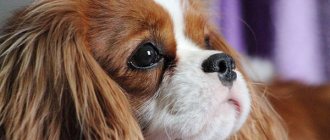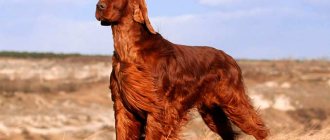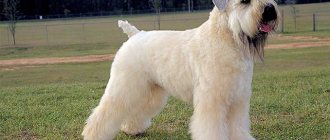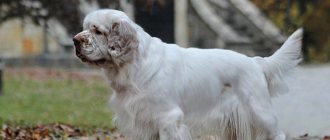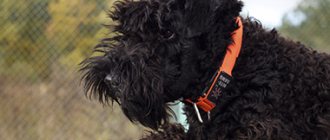Spaniels are one of the most popular hunting dogs.
Among their varieties, the most famous are Cocker Spaniels, Russian Spaniels, King Charles Spaniels and Cavalier Charles King Spaniels, but besides them there are less famous representatives that also deserve attention, including the Breton Espanole.
Breton Spaniels were developed in France and are still the most common hunting dog there.
Being the smallest among the cops, the Bretons are not inferior to them in terms of working qualities, which, combined with intelligence, complaisance and a friendly disposition, determined their popularity.
In this article you will find a comprehensive description of this wonderful breed, and also learn about the features of its maintenance.
Origin story
The Breton Spaniel or, as it is also called, the French Spaniel is a breed of dog native to the province of Brittany , France.
The first drawings depicting similar animals date back to the 18th century, but the first official mention dates back to 1850, when the priest of the French suburb of Davis described a hunting pointer with a naturally docked tail, used for gun hunting.
Representatives of this breed acquired their modern appearance only at the beginning of the 20th century. as a result of the selection of the best individuals and breeding work, during which, according to some sources, springer spaniels and English setters were used.
At the beginning of the 20th century. A Parisian all-breed exhibition was held, where the breed appeared before the canine community under its current name. These dogs quickly gained popularity due to their temperament, intelligence, gentle disposition and charming appearance.
NOTE!
The first breed standard was drawn up in 1907; Breton Spaniards received FCI recognition in 1954.
History of the origin of the breed
The Irish Water Spaniel is the largest and oldest species of all spaniels. According to experts, who refer to the remains found during excavations in the area of Lake Lagore, such dogs existed back in the 7th-8th centuries. In the south of Ireland in the second half of the 12th century, they could often be found in the area of the Shannon River, for which they received the name Shannon spaniels, as well as water spaniels.
According to surviving documents, in 1598, a certain Sir Robert Cecil made a gift to the King of France in the form of several such dogs. And in 1607, the first description of a spaniel appeared, loving water and covered with long, curly hair and a bare tail, for which the dogs were nicknamed rat-tailed or long-tailed spaniels. There is even a legend about the tail that St. Patrick was a great joker and once moved a dog’s hair from his tail to his head.
In the 19th century, dog breeding began to actively develop in Europe, and many breeds were subjected to selection. The water spaniel, which was crossed with a poodle, an Irish setter and a curly-haired retriever, also got it.
Since 1859, the Irish Water Spaniel breed began its exhibition career. True, the first prize was won in 1866. But the official standard was released only in 1990, with amendments in 2001.
The breed is recognized by many leading international Clubs and Federations, including FCI. And the Irish Water Spaniel is most widespread and popular in Ireland and England, as well as in the USA, where these dogs became the ancestors of the American Water Spaniels.
Description and standard
Breton Spaniards are the smallest of the cops, with a strong, stocky build and a harmonious silhouette with smooth lines. These are ideal, passionate and hardy hunting dogs, capable of well-orientated terrain, with good search abilities and the ability to work in any terrain.
Representatives of this breed are characterized by an unusual walking style - it seems that at a constant speed the dog jumps like a spring, while its body forms a solid ball.
FCI standard:
- the length of the body is equal to the height of the dog at the withers;
- tucked stomach;
- the back is short and straight, the loin is wide and short, the croup is straight and strong;
- the chest is wide;
- the neck is moderately long, muscular, cone-shaped;
- the skull is slightly rounded at the front and side;
- the head is wide, the transition from the forehead to the elongated muzzle is smooth;
- the ears are short, hanging and mobile, triangular in shape, set high, the upper part is covered with wavy hair;
- the eyes are oval, the iris is pigmented to match the coat;
- the nose is wide, the lobe is colored like the eyelids;
- scissor bite;
- limbs are slender, with developed muscles, set vertically and parallel, the front ones are shorter than the rear ones;
- the tail is straight, docked length is 3-6 cm, if it is of natural length, then no more than 10 cm, the absence of a tail from birth is not considered a defect.
The coat is smooth or slightly wavy, shorter in front than in back, with no undercoat.
Character traits
Breton Spaniards are lively, sociable and energetic dogs with a balanced and friendly character and appreciate an affectionate and caring attitude.
Representatives of this breed treat everyone well, they are happy to see even people they don’t know, so using them as watchmen and security guards will not work.
Bretons become very attached to their owner and do not tolerate loneliness well. Therefore, if you need to leave your pet alone, before doing so, you need to provide him with a long and active walk, so that in the absence of his owners, the dog sleeps, restoring his strength.
These dogs are smart and amenable to training; the main thing is not to scold your pet during the training process, much less physically punish it. This will only lead to the pet growing up scared and insecure.
Expert opinion
Kozhevin Semyon Kirillovich
Expert dog handler.
Bretons are friendly and have an affectionate disposition, but do not think that they lack firmness and inner strength. Representatives of this breed can be quite stubborn and assertive, which is why it is important to raise and socialize them correctly. These dogs are by nature wonderful companions, which explains their desire to always be close not only to their owner, but also to people in general. When getting such a pet, you should remember that these are true hunters, so it is advisable to use them for their intended purpose, taking them with you hunting, or at least provide them with regular and active walks and physical activity.
Advantages and disadvantages
Among the main advantages of representatives of this breed are:
- communication skills;
- lack of aggression;
- friendliness;
- devotion;
- endurance;
- intelligence and intelligence;
- love for children;
- ability to get along with other pets;
- lack of tendency to dominate.
Disadvantages of Breton epagnoles:
- inability to be used as watchmen and security guards;
- stubbornness;
- the need for proper education and socialization.
IMPORTANT!
In addition, representatives of this breed need long walks and physical activity, ideally regular participation in hunting.
Character and training
The characteristics of the French Spaniel breed differ sharply from its closest brothers. Four-legged animals are extremely calm, balanced, thoughtful, and prone to analyzing the situation . They are indifferent to the protection of the territory, although the owner (if necessary) will be fiercely defended.
The character of the French Spaniel is ideal for both a single owner and a large family. Dogs are kind and patient with children. The intelligence of four-legged animals allows them to find an approach and quickly establish contact with all family members, including other pets.
Photos of color variations
The official breed standard allows several coat color options for Breton Spaniels:
- white-red;
- black and white:
- white-brown;
- piebald;
- tricolor.
In the area of the muzzle, on the chest and limbs, the presence of specks or gray hair and the presence of a third color in the form of fiery spots are acceptable.
Relationship with other pets and children
Representatives of this breed get along well with children, play with them and patiently endure their pranks. At the same time, if the child is under school age, it is better not to leave him alone with the pet.
Breton Spaniards love to be the center of attention, but they do not tend to dominate and do not pretend to be leaders. Therefore, representatives of this breed, subject to proper and early socialization, get along without problems with other animals, including cats and birds.
Spaniel Club. All about spaniels.
The French spaniel is a strong, attractive dog and a reliable friend of its owner. It has a second name - French epañol. This is a representative of one of the oldest hunting breeds in France, known since the Middle Ages.
History of the breed
There are several versions of the origin of the breed. According to one of them, the long-haired setter was a distant descendant of the French spaniel. According to another, the birthplace of the breed is the Barbary Coast (north Africa), from where it came to Spain. The word "spaniel" means "Spanish". Adherents of this version believe that these dogs came from Spain to France around the 17th century. The breed, very popular at one time in France, was widely used during game hunting. It became widespread in all regions of the country, which over time led to the division into several types. As a result, each French province bred its own type of epagnoles. The uniformity of the breed was lost. The French Epagnole is the ancestor of various varieties of the breed. There were attempts to revive the purebred Spaniel breed, but subsequently the English breeds supplanted the French spaniels. Currently this is a fairly rare breed.
Description
Externally, the dog is well built, weighs 20-25 kg. The height at the withers for females is 55-61 cm, for males - 54-59 cm. The head is rectangular in shape, with a convex forehead and an elongated muzzle. It has large brown eyes and floppy ears that are rounded at the ends. The spaniel's strength and agility are confirmed by its wide chest, strong neck, and muscular paws. The short coat lies tightly to the body. Longer hairs adorn the ears, lower parts of the abdomen and chest, the back of the paws and the tail. The color of the French Epagnole is white with spots of reddish-brown.
Peculiarities
The French Epagnole is more suitable for hunting and keeping in rural areas. He is courageous, persistent, full of enthusiasm, and has good instincts. It is also possible to keep dogs of this breed in city apartments, provided they are provided with long walks. The Spaniel needs somewhere to put its energy, so it requires active exercise. The dog picks up a scent well, and after proper training can prove itself in other areas, even in rescue work. Carefully and with great attention, the spaniel examines the soil and notifies of the presence of game with the help of a stand. Calm, balanced, friendly character, intelligence and affection for the owner, kindness to children - these are the main qualities of the French spaniel. He shows distrust of strangers, but behaves calmly and does not bark in vain. Spaniels can have problems with their ears and vision, so you need to monitor the condition of their ears.
How to properly care?
Bretons are unpretentious dogs and do not require labor-intensive care. At the same time, it is important to carry out all hygiene procedures regularly, having accustomed your pet to them from early childhood.
Wool and bathing
Comb the coat 2-3 times a week, paying special attention to the fringes, since this is where tangles most often appear and thorns and grass get tangled in them.
The dog should be bathed as needed, but not more than once a month.
Ears
Inspect and clean the ears weekly from wax and dust with a cotton pad soaked in a special product or peroxide.
Claws
With regular active walks, the Breton's claws are ground down to the required length on their own. If this does not happen, they must be shortened with a guillotine nail cutter every 3-4 weeks - this prevents the so-called “unraveling” of the paws.
Eyes
Every morning, wipe with a lint-free cloth soaked in tea leaves or chamomile infusion.
Teeth
To prevent the appearance of plaque and tartar, your pet’s teeth should be brushed weekly using a special paste and brush for dogs. You should also give your Breton dog treats and chewing toys that help mechanically clean the teeth.
Care and maintenance
Regarding maintenance and care, this dog does not require much. The animal should be provided with active physical exercise, since the spaniel needs to spend its energy somewhere.
Epagnoles should be bathed as needed. To keep the coat in excellent condition, you need to brush it regularly (at least once a week).
This breed has a predisposition to ear and eye infections, so the condition of these organs must be carefully monitored.
If the dog is used as a hunter, then after each trip to the forest it must be carefully examined, since ticks and prickly grasses can attach to the animal.
From early spring to late autumn, French epañol must be treated with insecticidal agents (sprays, drops, shampoos). Dogs also need to undergo anthelmintic therapy once every 3-4 months.
The animal's diet should include meat, eggs, fish (without bones), offal, vegetables (raw and cooked), and cereals. industrial food as food , since they are designed taking into account all the characteristics of the dog (weight, height, age, physical activity, health).
Access to water must be constant, especially if dry industrial food is used when feeding the animal.
The dog should be fed twice a day - morning and evening, do not overfeed, and do not give any food between meals.
With good care, the lifespan of a French Spaniel is 12-14 years .
Life expectancy and major diseases
With proper care and proper maintenance conditions, Breton epagnoles live on average 14-15 years, remaining functional for quite a long time (up to 10-12 years).
In general, representatives of this breed have fairly good health, but they still have a tendency to develop diseases such as:
- dysplasia of the hip and elbow joints;
- epilepsy;
- hypothyroidism
- breast cancer in young whelping bitches;
- discoid lupus erythematosus;
- progressive retinal atrophy;
- ear infections.
In addition, Breton epagnoles are prone to infection with parasitic pathologies.
Nutritional Features
Most breeders prefer to feed their dogs commercial dry food because it is convenient and does not require much time to prepare the food. In addition, dry food contains all the necessary minerals and vitamins, and the special composition with which the granules are processed helps clean teeth.
It is important to choose only high-quality food that does not contain chemical flavors, flavor enhancers and dyes. The most suitable diets for representatives of this breed are made by the brands Acana, Orijen, Happy Dog, Royal Canin, Arden Grange, 1st Choice, Artemis, Almo Nature, Brit Premium, Canidae.
Natural feeding gives the owner the opportunity to independently choose the freshest and highest quality products for the dog, and the fact that all the nutrients in them are of natural origin improves their absorption by the pet’s body. A significant disadvantage of this diet is that it requires a lot of time to prepare food for the dog every day.
If you decide to feed your pet natural products, you should take into account that the diet must be balanced, and the diet must include:
- sea fish (cod, pollock, pollock, flounder, mullet, trout, hake);
- lean meat (beef, veal, turkey, chicken);
- porridge (rice, buckwheat, oatmeal);
- offal (heart, liver, lung, tripe);
- seasonal vegetables and fruits (carrots, pumpkin, bell peppers, zucchini, apples, bananas, pears);
- boiled eggs (no more than 2 per week);
- low-fat fermented milk products (cottage cheese, kefir, natural yogurt).
You should also give your pet a small amount of vegetable oils, which have a beneficial effect on the quality of the coat, and cartilage and tendons, which are beneficial for bones and joints.
The list of prohibited products includes:
- legumes;
- fat meat;
- river fish;
- potato;
- cabbage;
- smoked meats and sausages;
- fried and salty foods;
- citrus;
- tubular bones.
NOTE!
With a natural type of feeding, the dog must be given an additional complex of vitamins and minerals.
Features of maintenance and care
The French Spaniard feels better in a country house, where there is plenty of space for running and playing. You cannot put a pet in an enclosure - it needs constant contact with a person.
But the dog can be kept in the apartment. It is small, clean, with a faint dog smell. It is worth considering that with “urban” Breton epagnoles you need to walk a lot. And it is highly advisable to go 1-2 times a week to the forest or field for hunting.
Grooming
The Breton Spaniel is easy to care for. Enough:
- comb every week, during the molting period - every 3-4 days;
- bathe once every 3 months, washing every month is allowed, if the hair gets dirty before the “bath day” - use dry shampoo;
- inspect your ears every day and clean them 1-2 times a week - they are large and constantly clogged with dirt and wax;
- remove nitrous oxide from the eyes as necessary;
- trim nails if they do not grind down on their own;
- remove plaque from teeth every 7-10 days, and give toothpicks treats daily for self-cleaning.
Walk
Epagnole Breton loves to walk. He needs walking, running and hunting as well as food and sleep.
The Breton Spaniol needs to be walked 2-3 times a day for at least an hour. Moreover, this hour is allocated for games, running and exercises on the training ground. If the epagnol is unable to splash out energy and realize mental abilities every day, he will fall into frustration, become restless, nervous, and prone to destruction.
Breton epagnoles are very hardy. If they had their way, they would spend the whole day outside. Dogs are tireless - they can work for 8-9 hours without a break. This should be taken into account - the breed is not suitable for elderly and busy people.
Feeding
French spaniels are unpretentious in their diet. However, they tend to overeat and gain excess weight. Therefore, the volume of portions and the number of treats are regulated.
You can feed your Breton Epagnole with natural food or prepared food. Most owners prefer the second option - it’s easier to track calorie content and balanced diet.
When it comes to dry food, they prefer holistic or super-premium brands. Among them: Orijen, Acana, Go!, AATU, Grandorf, Wolfsblut.
How to choose a puppy?
You should purchase a puppy no earlier than he is 8-12 weeks old and only from professional breeders in pedigree nurseries, where you can look at the parents of the future pet, learn about their health and character, and also get advice from the breeder regarding the care and feeding of the puppy.
IMPORTANT!
Before purchasing a puppy, you must carefully examine it and make sure that it meets the breed standard and that there are no pathologies or developmental abnormalities. It should not emit an unpleasant ammonia odor, the puppy should not have a rash, irritation, increased lacrimation, lameness, a bloated abdomen and other symptoms of disease.
You should choose the most active and curious puppy from the litter who does not show aggression or cowardice and easily makes contact with strangers.
How to choose?
Before choosing a puppy , you need to decide what you need the dog for, how much you are willing to pay for it, and whether the conditions allow you to have an Irish water spaniel .
It is also worth thinking about whether you can pay enough attention to the dog and provide him with everything he needs.
IMPORTANT!
Before making a purchase, you need to carefully examine the baby to make sure that he is healthy and meets the breed standards.
It is also worth paying attention to the conditions in which the animals are kept in the kennel, as well as to the standing of the puppy’s parents.
To understand what gender to buy a dog, you should ask yourself: what is the purpose of the purchase?
If you need a companion, then it is better to choose a female, as they are more flexible and obedient . If the goal is exhibitions, then the best option is a male, because males look more impressive and more often take prizes.
If you plan to go hunting with your dog, then animals of both sexes are suitable for you, since both of them cope well with this task.
Price range
Prices for Breton Epagnole puppies in Russia vary greatly. So, you can buy a puppy from private breeders for about 15 thousand rubles, if the sale is at a lower price, this may indicate that the baby does not have documents confirming the origin, or his illness.
In specialized nurseries, representatives of the breed that fully comply with the standard, born from titled parents and with exhibition prospects cost an average of 35-50 thousand rubles.
Nurseries in Russia and CIS
The most famous Breton Espanole nurseries in Russia and the CIS:
- From Grin Valley, Russia, Simferopol (in Crimea);
- “Free Wind”, Ukraine, Kyiv;
- “Call of the Fields”, Russia, Moscow;
- Darkadivka, Ukraine, Kyiv;
- De La Casa De Cazador, Ukraine, Odessa;
- Don Field Spirit, Ukraine, Zaporozhye;
- “From the Free Wind”, Ukraine, Kyiv.
There are also many national breed clubs (NCB) of Breton Espanoli.

